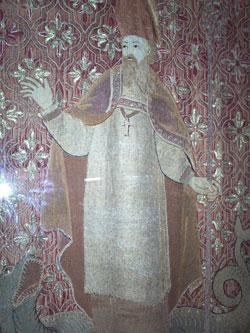
Feastday: March 12
Death: 573
Welsh bishop. Probably of Roman-Welsh descent, he was the son of a local Welsh chieftain. He studied under St. Illtyd at the Ynys Byr monastery and, according to tradition, was granted permission to become a hermit. Ordained, he nevertheless gathered around himself a group of followers and acquired such a reputation for goodness that a king in Brittany asked him to preach the Christian faith to his subjects. Paul sailed to Caldey Island in Brittany soon after and founded a monastery at PorzPol on the island of Quessant. Later he established himself and his followers at Ouismor. There, over his objections, he was made a bishop, although he was finally permitted to resign after several years and retire to Batz. He was reputed to be able to perform miracles, the accounts of which are generally considered unreliable owing to the exorbitant nature of the claims.
For other uses, see Saint Paulinus.Paul Aurelian (known in Breton as Paol Aorelian or Saint Pol de Léon and in Latin as Paulinus Aurelianus) was a 6th-century Welshman who became first bishop of the See of Léon and one of the seven founder saints of Brittany. He allegedly died in 575, rumoured to have lived to the age of 140, after having been assisted in his labors by three successive coadjutors. This suggests that several Pauls have been conflated. Gilbert Hunter Doble thought that he might have been Saint Paulinus of Wales.
Family
According to his hagiographic Life, completed in 884 by a Breton monk named Wrmonoc of Landévennec Abbey, Paul was the son of a Welsh chieftain named Perphirius/Porphyrius ("clad in purple"), from Penychen in Glamorgan. He was later given three saintly sister-martyrs; Juthwara, Sidwell and Wulvela.
It was also suggested that he may have been related to Ambrosius Aurelianus, both of them possibly active in Brittany at some points of their lives. Coincidentally to the saxon raids over British islands, it supports the idea of an organized migration of local brythonic population under the rules of leaders belonging to the clergy and to the local nobility.
In the Life of Cadoc the princely founder of Llancarfan is reckoned the son of Gwynllyw, eponymous founder of the cantref of Gwynllwg and the son of Glywys. Medieval sources give Gwynllyw a brother, called "Pawl", who is chief of neighbouring Penychen.
Career
 St Pol, as represented in the parish church of Saint-Thegonnec, Brittany.
St Pol, as represented in the parish church of Saint-Thegonnec, Brittany.
Paul first was a pupil of Saint Illtud at Llantwit Major. Later, he studied on Caldey Island with Samson of Dol and Gildas.
He went to Brittany, establishing monasteries in Finistère on the northwest coast of Brittany, at Lampaul on the island of Ushant (French Ouessant), on the island of Batz and at Ocsimor, now the city of Saint-Pol-de-Léon, where he is said to have founded a monastery in an abandoned fort. He was consecrated bishop at Ocsimor under the authority of Childebert, King of the Franks.
Paul was a vegetarian. One account says he died on the island of Batz. He was first buried at Saint-Pol-de-Léon, but his relics were later transferred to Fleury Abbey. His bell is kept at Saint-Pol. His feast day is 12 March.
Paulinus of Wales
- For other saints named Paulinus, see Saint Paulinus.
G. H. Doble thought Saint Paul Aurelian might be the same as Saint Paulinus of Wales, revered in Carmarthenshire, southwest Wales as a hermit and teacher at a place usually identified as Whitland. Hywel David Emanuel considered the identification of Paul Aurelian with the Carmarthenshire Paulinus as doubtful.
In Rhigyfarch's Life of S. David (chapter x), Saint David is stated to have completed his education under S. Paulinus (Paulens), who is described as a "scribe, a disciple of S. Germanus the bishop". When Paulinus became blind, David is said to have miraculously restored his sight.
Paulinus of Wales founded churches and chapels around Llandovery. He is said to have taught Saint Teilo and to have nominated David to speak at the Synod of Llanddewi Brefi (in around 545). Claims to having founded the church at Paul are dubious.
A 6th century inscribed stone found at Caeo in Carmarthenshire, now in the Carmarthen Museum, appears to honour him as "preserver of the faith, constant lover of his country, champion of righteousness". His feast day is 23 November.





